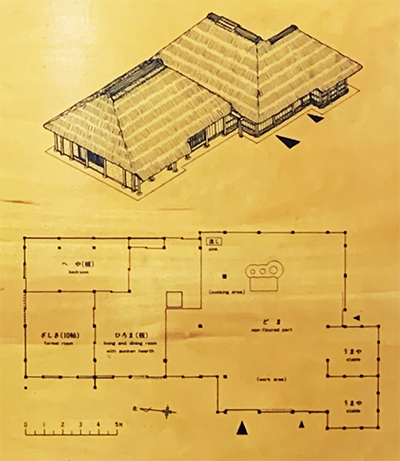

古民家シリーズでの「日本人のいい家」連載継続中。
コロナ禍で「非寛容」的な閉塞状況が続いております。
これから、やや下火になっていったとしても、こういう「閉塞」圧力は
しばらくの間は続くというか、それがアフターコロナ時代の特徴になるかも。
ようやく「緊急事態宣言」は収束したが「見通しが甘い」みたいな批判も出てくる。
こういった論調が果てしなく続くのをある程度、覚悟しなければならない。
安全側で行動していくことを考えたら抑制行動を採用する方が安全ではある。
たぶん、多くの社会人はみなそのような思いを持っているでしょうね。
しかしそんな社会風潮に対しての異議申し立てのように
「うっせぇわ」というシャウト調の流行歌が出てきたという。
YouTubeの再生回数を見たら1億回を超えている。
行動規範、社会常識への従順さを強制する同調圧力に対し
高校生と言われる発信者ははげしくシャウトして反発を示している。
この歌を聴いていると、前述のような社会傾向に対して相当の屈折感が
若者、社会全体として鬱積してきているように思います。
それがある臨界点を越えるのかどうか、ちょっと予測不可能。
おっと、横道ズレまくり(笑)。
やはりブログなので、個人としての感覚、気付くことは書きたくなる。
このあたり個人名と組織名を冠したブログというのは加減が難しい。
本日は常陸・旧太田家の食卓・囲炉裏端と寝室「へや」の様子。
この家では調理火力がこの囲炉裏と土間のかまどの2つです。
囲炉裏はかまどからの「輻射熱」も感じられる位置、
土間との接点、端部に装置されています。
ちょうどそれは室内雨樋が屋根の谷を通っている位置にも当たっている。

間取り図で見たらちょうど家の真ん中、分棟の中間に配置とわかる。
囲炉裏は日本では食卓であるのか、採暖装置であるのか微妙な存在。
その中間的な存在とでも言えるのかも知れない。
古民家では西洋式の住宅での「ダイニング」という存在はほぼない。
生活文化として「テーブルマナー」みたいな様式もほぼなかったと思います。
日本の会食機会・食事は膳部で供されることが多いことも一因か。
しかしそれ以上に、普段の家族での会食は「囲炉裏端」であることが大きい。
囲炉裏は意識の上では「暖房」装置だけれど、採暖の用しか足せていない。
採暖と暖房の違いということに日本は「気付かなかった」ともいえる。
世界標準的には暖房とは、空間全体の気温上昇させる目的意識だったのに対して
採暖では、体感、それも火に当たる部位だけの体温上昇を図ってきた。
そして料理も基本はこの囲炉裏火に掛けられた「鍋料理」だった。
その料理スタイルに最適化された「食卓空間」が囲炉裏端だったともいえる。
直火での採暖と鍋料理飲食での体温上昇とが、日本人の快適認識だった。
この認識は非常に興味深いのではないだろうか。
言うまでもないけれど、直火採暖では輻射熱の当たらない背中側は
ただただ熱が逃げていくことになる。
「綿入れ」のような体温維持着衣とワンセットだった。
こういう環境条件ではヒートショック的な健康被害が容易に想像できる。
とくに古民家では屋根までの大空間であり、放熱の「効率」は非常に高かった。
食事という人間社会のもっとも基本的な空間仕様が与えた影響は
さてどういうものだったのか、非常に決定的だったと思いますね。
一方の寝室空間は家族での雑魚寝状態が想像できる1室空間。
見るとおり窓とか採光の工夫などは見られない。
おたがいの体温、ぬくもりを「湯たんぽ」にして気温低下をしのぐ様子がわかる。
ふとんという放熱防止策で、おたがいのぬくもりで支え合う。
熱環境の些細な分析から、日本の生活文化の根源を考えて行くことは、
面白い民族性の再発見機会になって行くかも知れません。
English version⬇
[Healing of private houses / Sleeping when eating / Good Japanese house ㉖-7]
“Good Japanese House” is being serialized in the old folk house series.
The corona-stricken and “intolerant” obstruction continues.
From now on, even if it goes down a little, this kind of “blocking” pressure will be
It will continue for a while, or it may be a feature of the after-corona era.
The “state of emergency” has finally come to an end, but criticisms such as “the outlook is unsatisfactory” have come out.
We must be prepared to some extent that this tone will continue endlessly.
It is safer to adopt restraint behavior when considering acting on the safe side.
Perhaps many working people all have such thoughts.
But like an objection to such a social climate
It is said that a shout-like popular song called “Usseewa” has come out.
Looking at the number of views on YouTube, it has exceeded 100 million times.
Against sympathetic pressure to enforce obedience to the code of conduct, common sense
The caller, who is said to be a high school student, shouts violently and shows a backlash.
When listening to this song, there is a considerable sense of refraction to the social tendencies mentioned above.
I think that youth and society as a whole are getting sick.
It’s a bit unpredictable whether it will cross a certain critical point.
Oops, the side streets are misaligned (laughs).
It’s still a blog, so I want to write about my personal feelings and things I notice.
It is difficult to adjust the blog with the personal name and organization name around here.
Today is the state of the dining table, hearth end and bedroom “Heya” of the Hitachi / former Ota family.
In this house, the cooking firepower is two, the hearth and the earthenware kamado.
The hearth is in a position where you can feel the “radiant heat” from the kamado.
It is installed at the end, which is the point of contact with the soil.
It also hits the position where the indoor gutter passes through the valley of the roof.
If you look at the floor plan, you can see that it is located right in the middle of the house, in the middle of the branch building.
In Japan, the hearth is a delicate existence whether it is a dining table or a heating device.
It may be said that it is an intermediate existence.
In old folk houses, there is almost no “dining” in Western-style houses.
I don’t think there was a style like “table manners” as a living culture.
One of the reasons is that Japanese dinner opportunities and meals are often served at the dining room.
But more than that, the usual family dinner is at the “hearth”.
The hearth is consciously a “heating” device, but it can only be used for heating.
It can be said that Japan “did not notice” the difference between heating and heating.
Whereas the world standard, heating was a sense of purpose to raise the temperature of the entire space.
In the warming, I tried to feel the temperature of the body only in the part that hits the fire.
And the cooking was basically “nabe-dish” that was hung on the hearth.
It can be said that the “dining table space” optimized for the cooking style was the hearth end.
The Japanese people’s perception of comfort was that the temperature was raised by direct fire and the body temperature was raised by eating and drinking hot pot.
Isn’t this recognition very interesting?
Needless to say, on the back side where radiant heat does not hit in direct fire heating
The heat just escapes.
It was a set with body temperature maintenance clothes like “cotton case”.
Under such environmental conditions, heat shock-like health hazards can be easily imagined.
Especially in an old folk house, it was a large space up to the roof, and the “efficiency” of heat dissipation was very high.
The influence of the most basic spatial specification of human society, food, is
Well, I think it was very decisive what it was like.
One bedroom space is a one-room space where you can imagine a family sleeping with small fish.
As you can see, there are no windows or ingenuity in daylighting.
You can see how each person’s body temperature and warmth are made into “hot water bottles” to overcome the temperature drop.
Futon is a heat dissipation prevention measure that supports each other with the warmth of each other.
Thinking about the roots of Japanese living culture from a trivial analysis of the thermal environment
It may be an opportunity to rediscover an interesting ethnicity.
Posted on 3月 24th, 2021 by 三木 奎吾
Filed under: 住宅マーケティング, 日本社会・文化研究







コメントを投稿
「※誹謗中傷や、悪意のある書き込み、営利目的などのコメントを防ぐために、投稿された全てのコメントは一時的に保留されますのでご了承ください。」
You must be logged in to post a comment.